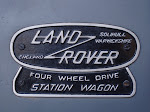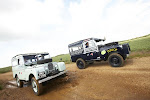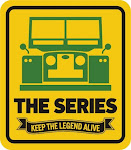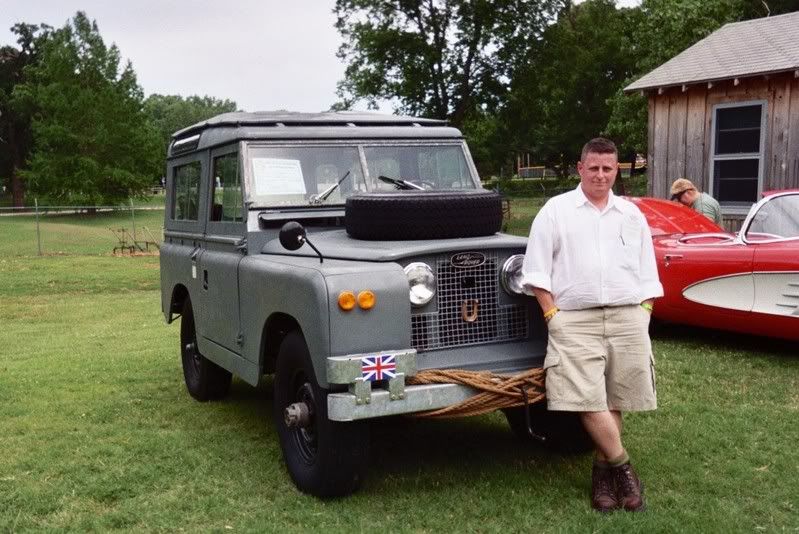Unfortunately several other things have gotten in the way during the past few weeks. I have worked some on Grover but not as much as planned and not all that much to write about.
However, this past Friday I got to work several hours on Grover as well as a couple of hours on Saturday.
As the title states: The Engine is Out!!!
Here are a few pics for your amusement.
 Here is the right side of the engine. At the time of this pic it was still on the chassis.
Here is the right side of the engine. At the time of this pic it was still on the chassis.From left to right you can see the opening where the fuel pump was attached with the side cover still in place. Next, the pinkish triangular, is the housing for the distributor & driving gear. Directly below the distributor housing is the oil filter housing port. The last opening you can see is for the oil filler tube.
 Since I mentioned the fuel pump let me throw this picture in. It's a better view of the rusty sediment in the bottom of the filter bowl.
Since I mentioned the fuel pump let me throw this picture in. It's a better view of the rusty sediment in the bottom of the filter bowl. Here's a closer look at the distributor & driving gear housing. You can see the drive shaft coupling and vertical drive gear assembly.
Here's a closer look at the distributor & driving gear housing. You can see the drive shaft coupling and vertical drive gear assembly.The pink stuff is what's left of the gasket.
 This is a cool picture. you can see some of the gears in the engine through some of the openings. In case you are wondering what the rag is there for I placed it in the distributor & driving gear housing opening so nothing falls in there and gets lost.
This is a cool picture. you can see some of the gears in the engine through some of the openings. In case you are wondering what the rag is there for I placed it in the distributor & driving gear housing opening so nothing falls in there and gets lost. This is the left side of the engine.
This is the left side of the engine.There are a couple of interesting items (at least to me) on this side. If you look towards the center of the picture you will see a brass item that looks somewhat like a water spigot; it's a drain tap for water.
There other item is located towards the top right hand side of the picture. It's a cylindrical item on top of the cylinder head and has a little handle on top of it. That's another water spigot/tap but this time for the original heater that use to be in Grover. BTW - the heater came with Grover but in pieces in a beer box.
The next couple of pictures are of some of the manifold ports. You can see some of the gears inside as well as the carbon/coke buildup. At this point I'm not planning on tearing apart the innards of the engine, but we'll see.


You'll notice that I've left the gasket in place. I have a plan for this thing and will fill you in later.

Here's the opening where the starter goes in to connect with the flywheel.
It was disappointing to see the rust but I've been told this happens when an engine just sits without use. Still, I have a nagging feeling that water is getting in there somehow.
Now comes the interesting part - the removal of the engine. I have never done this before. The closest I came to doing this was when I was 16 back in 1982. I had a '73 Chevy Camero that needed an engine rebuild. I was allowed to take off everything I could, but my brother and one of my dad's mechanics took the engine out. Even though I was allowed to take the engine apart I wasn't allowed to help put it back together. All they let me do was watch them put it back together. In fact, there have been many skeptics who have said I can't do this - especially by myself. A few have even suggested that the engine, let alone Grover, will never get put back together. My dad just walks out to the shop, looks around, and shakes his head.
 Anyway, here is the engine all trussed up and ready to go, just one hitch, the transmission is still attached.
Anyway, here is the engine all trussed up and ready to go, just one hitch, the transmission is still attached.So, with a large rubber mallet, a putty knife, screw driver and pry bar the transmission came off. I whacked the thing with the mallet all the way around to break the connection. Then, starting with the putty knife, I slowly pried the bell housing away. After several 'whacks', a few pries, and some backward rolling of the chassis, the engine and transmission separated.
 And there it is - in all it's glory - the 4 cylinder, 2.25 litre petrol engine.
And there it is - in all it's glory - the 4 cylinder, 2.25 litre petrol engine.One of the main mechanical concerns with Grover over the past year has been the clutch, it just hasn't been working right at all. It was grinding terribly and becoming more and more difficult to shift out of one gear and into another. So, with the engine out my attention turned to the clutch.
 At this point the pressure plate doesn't look too bad at all.
At this point the pressure plate doesn't look too bad at all.
The clutch disk doesn't look too bad either, but there is some rust on it. Not sure how this rust would effect the clutch, perhaps it doesn't.
The next two pictures are of the flywheel and the flywheel housing.
 The straight on shot makes the flywheel look pretty good, but there is more rust on the face of it.
The straight on shot makes the flywheel look pretty good, but there is more rust on the face of it.
An angled shot tells another story, the rust is very noticeable. I guess I need to figure out how to clean this thing before putting it back together.
The best part is is that there are no missing gear teeth or noticeable metal shavings found, so, all in all the clutch seems sound.
 Before returning to the engine, here's a look inside the bell housing.
Before returning to the engine, here's a look inside the bell housing.I figured it would be oily inside the thing, but it looks like there is some sort of sediment in the oil. Not sure if this is dirt or what, however, the gears look good.
Now, back to the engine.
 Here's the inside of the flywheel housing. The is a lot of oil in it along with more of that sediment. It actually looks like soot or graphite powder. I'm wondering it it is fine metal shavings from the starter gears and the flywheel.
Here's the inside of the flywheel housing. The is a lot of oil in it along with more of that sediment. It actually looks like soot or graphite powder. I'm wondering it it is fine metal shavings from the starter gears and the flywheel.The main thing to be noticed in the photo is the stain that goes from dead center to the 6 o'clock position. This makes me think that the rear main oil seal is leaking. So, that seal will be replaced.
Once the flywheel housing was removed I had the chance to look at the O ring in the housing. It's there and intact, but it doesn't look as thick as it should. The O ring doesn't fill the gap that it sets in; it actually looks like it should be thicker by a third.
 And here is the engine sans flywheel housing.
And here is the engine sans flywheel housing.The crankshaft flange appears to be in great shape, but it looks like the rear main oil seal is going to be a bugger to remove and refit.
Surprisingly, the paint under the flywheel housing looks great! I wonder if the whole engine use to be that color? I thought Land Rover engine colors were pastel green, perhaps not.
Last but not least - here's this post's money shots - the engine on the stand!!
 Putting this puppy on a stand turned out to be harder than I thought. The bolts that my brother supplied with the stand do not fit the engine block. The bolts needed to hold the engine are 3/8 x 24.
Putting this puppy on a stand turned out to be harder than I thought. The bolts that my brother supplied with the stand do not fit the engine block. The bolts needed to hold the engine are 3/8 x 24. So, off to Lowe's I went Saturday morning to get some. They didn't have any in the length need. I then went to a specialty supply house. Luckily they had some - barely. When I told the guy what they were being used for he gave me a look like "boy, your nuts, engines don't have bolts like that". After explaining it to him, and showing him one of the actual bolts, you could see the light bulb come on. So then he started talking about the Whitworth standard and old British engines.
Anyway, I finally got home and put the engine on the stand.
 And there you have it.
And there you have it.Once I'm done with the chassis and such I'll get started on the engine.
For now I'm going to cover it and place it in a corner.
Up next - the removal of the transmission, drive shafts and the exhaust system. This ought to be fun!!
Till next time...
Cheers!
Larry










No comments:
Post a Comment